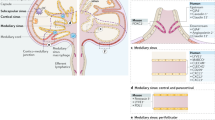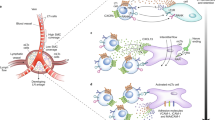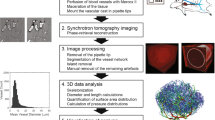Abstract
PREVIOUS communications to Nature have shown (a) that lymph-borne carbon diffusing into rat lymph node cortex from the subcapsular sinus is deflected by a barrier system around the stromal follicle or ‘centron’1; (b) that lymph-borne iron dextran within the medullary cords is prevented from entering the cortex by a similar type of barrier system2.
This is a preview of subscription content, access via your institution
Access options
Subscribe to this journal
Receive 51 print issues and online access
$199.00 per year
only $3.90 per issue
Buy this article
- Purchase on Springer Link
- Instant access to full article PDF
Prices may be subject to local taxes which are calculated during checkout
Similar content being viewed by others
References
Menzies, D. W., Nature, 208, 163 (1965).
Menzies, D. W., Nature, (in the press).
Menzies, D. W., Stain Technol., 37, 235 (1962).
Menzies, D. W., Stain Technol., 38, 157 (1963).
Author information
Authors and Affiliations
Rights and permissions
About this article
Cite this article
MENZIES, D. Centron–Cortex and Cortex–Medullary Cord Junctions in the Rat Lymph Node, as seen in 1µ Paraffin Sections. Nature 210, 431–432 (1966). https://doi.org/10.1038/210431a0
Issue Date:
DOI: https://doi.org/10.1038/210431a0
This article is cited by
Comments
By submitting a comment you agree to abide by our Terms and Community Guidelines. If you find something abusive or that does not comply with our terms or guidelines please flag it as inappropriate.



